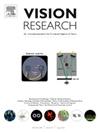The metrics of regressive saccades during reading in 13 written languages
IF 1.4
4区 心理学
Q4 NEUROSCIENCES
引用次数: 0
Abstract
A well-documented phenomenon in research on eye movement control during reading is the systematic relationship between the landing positions of forward saccades and target word characteristics. However, the behaviour of regressive saccades, which move the eyes in the opposite direction, remains less explored. This study delves into the landing positions of regressive saccades, emphasizing the distinction between intra-word and inter-word regressions, across diverse languages. Using data from the MECO L1 project, which includes eye-tracking data from 589 participants across 13 languages, we scrutinize the precise landing positions of regressions vis-à-vis forward saccades. Our analysis shows a robust effect of launch distance on landing positions for progressive saccades, with undershoots increasing as launch distance grows and overshoots with shorter launch distances. In contrast, regressive inter-word saccades show only minimal variation in landing positions, typically landing near the centre of the target word regardless of launch distance or word length. Intra-word regressions, however, display a pattern similar to progressive saccades, where the landing position is influenced by launch distance, tending to overshoot the optimal viewing position as the launch site moves away from the word’s end. This pattern is consistent across all languages. These findings support the notion of cross-linguistic universality in oculomotor control mechanisms during reading, particularly the precision of regressive saccades. They align with the spatial coding hypothesis, suggesting that precise spatial memory of word positions guides regressive saccades.
13种书面语言阅读中倒退扫视的度量
在阅读过程中眼球运动控制的研究中,一个有充分证据的现象是前扫视的着落位置与目标词特征之间的系统关系。然而,眼睛向相反方向移动的退行性扫视行为仍未得到充分研究。本研究探讨了倒退扫视的着陆位置,强调了不同语言中词内和词间倒退的区别。使用MECO L1项目的数据,其中包括来自13种语言的589名参与者的眼球追踪数据,我们仔细检查了-à-vis前扫视回归的精确着陆位置。我们的分析表明,发射距离对渐进式扫视的着陆位置有很强的影响,随着发射距离的增加,过冲量增加,随着发射距离的缩短,过冲量增加。相比之下,回归词间扫视在着陆位置上只有很小的变化,通常着陆在目标词的中心附近,而不管发射距离或单词长度。然而,单词内回归显示了一种类似于递进扫视的模式,其中着陆位置受到发射距离的影响,随着发射地点远离单词的末端,往往会超过最佳观看位置。这种模式在所有语言中都是一致的。这些发现支持了阅读过程中动眼肌控制机制的跨语言普遍性,特别是退化扫视的准确性。它们与空间编码假说一致,表明对单词位置的精确空间记忆引导了倒退性扫视。
本文章由计算机程序翻译,如有差异,请以英文原文为准。
求助全文
约1分钟内获得全文
求助全文
来源期刊

Vision Research
医学-神经科学
CiteScore
3.70
自引率
16.70%
发文量
111
审稿时长
66 days
期刊介绍:
Vision Research is a journal devoted to the functional aspects of human, vertebrate and invertebrate vision and publishes experimental and observational studies, reviews, and theoretical and computational analyses. Vision Research also publishes clinical studies relevant to normal visual function and basic research relevant to visual dysfunction or its clinical investigation. Functional aspects of vision is interpreted broadly, ranging from molecular and cellular function to perception and behavior. Detailed descriptions are encouraged but enough introductory background should be included for non-specialists. Theoretical and computational papers should give a sense of order to the facts or point to new verifiable observations. Papers dealing with questions in the history of vision science should stress the development of ideas in the field.
 求助内容:
求助内容: 应助结果提醒方式:
应助结果提醒方式:


